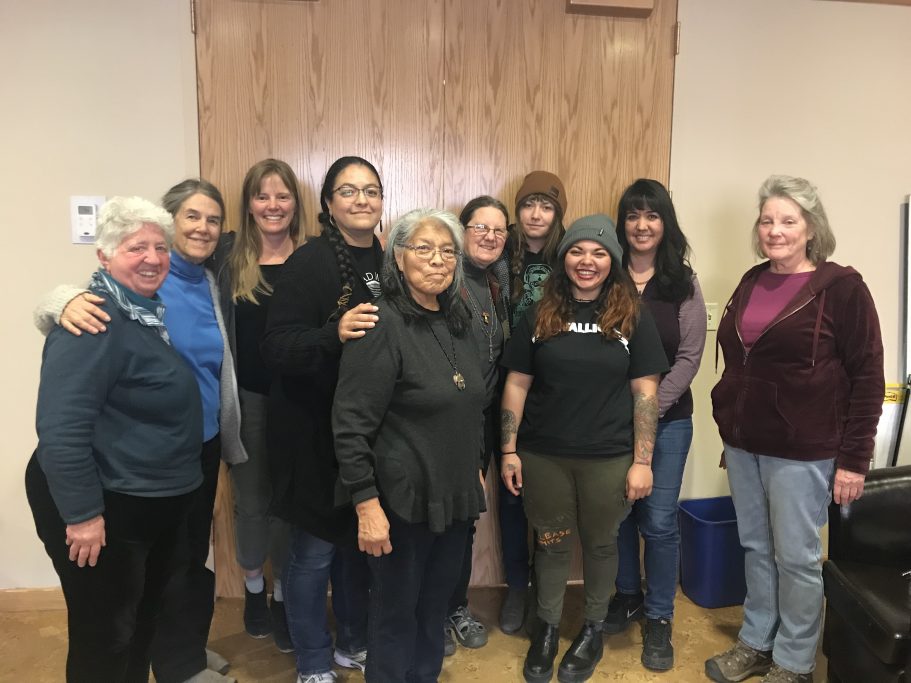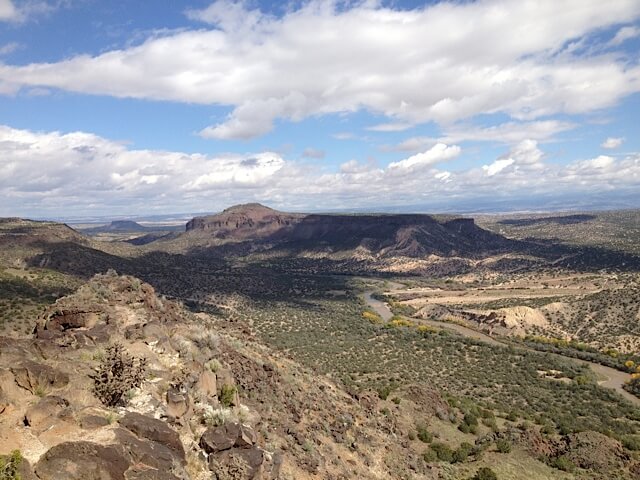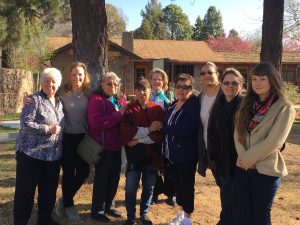Featured Communities – Communities for Clean Water, New Mexico
This piece was written by Rachel Conn, Amigos Bravos, a member of Communities for Clean Water.
 Communities for Clean Water (CCW) is a coalition of New Mexico land-based, native, faith, and environmental organizations whose mission is to ensure that community waters impacted by Los Alamos National Laboratory (LANL) are kept safe for drinking, agriculture, sacred ceremonies, and a sustainable future[1]. CCW member organizations are rooted in a variety of traditions and share a common awareness that caring for clean water is a moral and ethical responsibility.
Communities for Clean Water (CCW) is a coalition of New Mexico land-based, native, faith, and environmental organizations whose mission is to ensure that community waters impacted by Los Alamos National Laboratory (LANL) are kept safe for drinking, agriculture, sacred ceremonies, and a sustainable future[1]. CCW member organizations are rooted in a variety of traditions and share a common awareness that caring for clean water is a moral and ethical responsibility.
The Problem
Toxic waste from LANL continues to enter the waters of the Rio Grande watershed—including drinking and irrigation water shared by downstream tribal communities, Santa Fe, Espanola Valley, Albuquerque, Los Alamos, and other surrounding communities. The Department of Energy (DOE) has identified over 2,100 unlined dump sites at LANL containing harmful toxins including PCBs, hexavalent chromium, PFAS, 1-4 dioxane, heavy metals, and radionuclides.[2]
These toxins readily bind to soil, and each time there is a rainstorm or snowstorm, they are washed into the many canyons streams on LANL property. From the canyon streams, the toxins flow into wetlands, groundwater, and the Rio Grande. When disturbed by stormwater, forest fires, or human activity, toxins are also released into the air and enter the water of downwind and downstream communities. These communities, living on the sacred lands of Tewa Peoples, depend on clean water for drinking, sacred ceremony, reproduction, growing food, raising animals, recreating, and overall well-being.
Using CWA Legal Tools to Protect Community Waters
After conducting extension outreach to tribal entities and local community representatives, CCW used the citizen suit provision of the Clean Water Act to file a lawsuit against the US Department of Energy (DOE) for violations at Los Alamos National Laboratory (LANL). The complaint laid out four specific violations of the Clean Water Act: failure to conduct adequate monitoring; failure to report violations; failure to have pollution controls in place; and unauthorized discharges. While this legal process was moving forward the Environmental Protection Agency (EPA)[3], in response to both concerns raised by CCW in the citizens suit as well as concerns raised by the New Mexico State Environment Department, issued a draft individual industrial stormwater discharge permit[4] to DOE and LANL. CCW appealed this permit citing lack of requirements for representative monitoring, too lax of a schedule for Best Management Practice (BMP) implementation, and lack of numeric effluent limits. CCW successfully used both the CWA lawsuit and the NPDES permit appeal to leverage a strong stipulated agreement on the permit appeal and a settlement on the lawsuit. The negotiation meetings were quite a sight! CCW’s team was made up of a female team of representatives including Native women, two Catholic sisters, a pregnant environmentalist, and other conservation leaders, all represented by a very pregnant attorney, while the DOE and LANL team, was made up of almost all male attorneys – some of which were hired from a highly paid D.C. firm.
The provisions of the stipulated agreement and settlement laid out a strong regulatory and public participation structure for controlling toxic stormwater discharges from 400 polluted sites at LANL. Specifics of the agreements included:
- High priority sites to be cleaned up within 2 years
- All other sites to be cleaned up within 5 years
- Use of Target Action Levels based on water quality standards as a compliance requirement
- More comprehensive monitoring
- Funding for CCW to hire experts
- CCW access to certain sites
- Opportunity for the public to receive email notification of permit submittals.
- Permit specific website
- Two public meetings per year
- One technical meeting per year
- Review and CCW input into meeting agendas
Most of these requirements, including the two public meetings, email notification, and the public website, were agreed upon as part of the permit appeal stipulated agreement and were written into the final individual industrial stormwater permit. Several of these requirements, such as funding for CCW to hire experts, access to sites, and the annual technical meeting, were included in the final settlement agreement to the lawsuit.
In the years since the settlement agreement CCW worked with their experts to monitor implementation of the permit and at times worked collaboratively with the Permittees to identify opportunities to utilize green infrastructure techniques to capture and treat the stormwater discharges. As per the stipulated agreement, CCW engaged in technical meetings with the permittees. These meetings were opportunities for CCW members to share the historical and cultural significance of the waters and lands of the Pajarito Plateau (where discharges were located) as well as the deep traditional knowledge and ways of thinking and being of Tewa Peoples with the Permittee’s technical and leadership teams.
A Moving Regulatory Target: Use of Residual Designation Authority (RDA) and Municipal Separate Storm Sewer System (MS4) Permit Requirements
As more sampling was collected and (BMPs) were installed, Permittees directed attention to upstream off-site runoff from developed areas (parking lots, buildings, roads etc.) as a source of the high level of pollutants being seen at the downstream industrial stormwater sites. While to certain extent CCW viewed this approach by permittees as shifting the blame and avoid cleanup responsibilities, there was some truth to the problem of contaminated runoff from developed areas upstream from the permitted industrial sites. The permittees collected a large amount of data and information in their attempts to support their claims that high levels of pollutants were attributable to upstream sources.
Amigos Bravos, one of the member groups of CCW, used this data, along with decades of monitoring by the state, to make the case that discharges from developed and urbanized areas in Los Alamos County needed NPDES stormwater permit coverage. Amigos Bravos submitted a petition to EPA under the Clean Water Act’s residual designation authority (RDA)[5] making the case that stormwater discharges from developed areas in Los Alamos County were causing or contributing to violations of water quality standards and that permit coverage was necessary. While EPA was slow to act (Amigos Bravos filed a notice of intent to sue against EPA under citizen suit provisions of the Clean Water Act for failure to make a final determination), EPA ultimately acted on the petition and made a final determination that discharges from developed areas in Los Alamos County, including discharges from urbanized areas on LANL property, were contributing to water quality standards violations and a Municipal Separate Storm Sewer System (MS4) NPDES permit was required.
 Water Quality Standards Shenanigans
Water Quality Standards Shenanigans
Of course, permits are only effective if the water quality standards that dictate the permit compliance goals are strong and appropriate. The Permittees have spent considerable time and resources advocating for customized standards for waters on their property. Decades ago LANL successfully advocated for all the waters within their property boundaries to be assigned to separate water quality segments. These segments, which were broken out by hydrology, were less protected than waters with similar hydrology in other parts of the state. For example, intermittent[6] waters at LANL are assigned the less protective “limited aquatic life” designated use while other intermittent waters in New Mexico are assigned the more protective “aquatic life” designated use.
In addition, as is common (and problematic) throughout New Mexico, LANL water segments have upstream and downstream boundaries that are delineated by hydrology. For example, most segments are defined by language like “the perennial[7] reaches” of a particular waterbody. This sets up a problem where, as the climate warms and many previously perennial waters turn into intermittent or ephemeral[8] waters, portions of waterbodies will be automatically shifted from a segment with higher protections to a segment with lower protections without any oversight or analysis.
Typically, when changes in water quality standards result in downgrading of protections, a Use Attainability Analysis (UAA) is required. However, because changing hydrology does not require a change in the language in the water quality standards themselves, there isn’t a specific action or proposed change to the standards that will trigger the UAA process.
Triennial Review
CCW has spent considerable time pushing back on inappropriate water quality standard designations for LANL waters. Working with community partners and pro bono legal representation by environmental law firms, CCW has been successful at pushing for the use of hydrology protocols to identify and delineate by landmarks the current perennial, intermittent, and ephemeral reaches of LANL waters, thus insulating the waters from automatic downgrading. CCW has worked with technical experts to present technical testimony at the New Mexico Triennial Review of Water Quality Standards where they successfully defeated LANL proposals to limit monitoring provisions, gut the definition of toxic pollutants, and weaken criteria for contaminants such as Aluminum and other heavy metals.
 CCW held trainings for youth and community members and disseminated factsheets about how to give public testimony at the Triennial Review hearing. As a result of these trainings and factsheets numerous members, including a group of predominately Indigenous and Hispanic youth, gave public testimony during several of the Triennial Review proceedings. This public engagement, combined with the strong legal and technical case presented by CCW resulted in the defeat of many damaging proposals including proposals to weaken the definition of toxic pollutants and limit monitoring of toxic pollutants. In addition, CCW successfully advocated for the adoption of good changes to the state water quality standards such as adding a definition of climate change, a definition of emerging contaminants, and strong emerging contaminant monitoring provisions.
CCW held trainings for youth and community members and disseminated factsheets about how to give public testimony at the Triennial Review hearing. As a result of these trainings and factsheets numerous members, including a group of predominately Indigenous and Hispanic youth, gave public testimony during several of the Triennial Review proceedings. This public engagement, combined with the strong legal and technical case presented by CCW resulted in the defeat of many damaging proposals including proposals to weaken the definition of toxic pollutants and limit monitoring of toxic pollutants. In addition, CCW successfully advocated for the adoption of good changes to the state water quality standards such as adding a definition of climate change, a definition of emerging contaminants, and strong emerging contaminant monitoring provisions.
Looking Ahead
CCW continues to amplify community voices and empower collective action to stop LANL’s toxic discharges from polluting the waters of downstream tribal and land-based communities. CCW also prepares young people and community members to become leaders and champions for clean water. The Clean Water Act is a critical tool in this work and continues to be used by CCW to:
- Enforce current pollution controls and hold LANL accountable to environmental and health and safety standards;
- Strengthen EPA restrictions on toxic discharges at LANL;
- Encourage LANL to utilize its unique position to research, implement, and assess Low Impact Development (LID) and Green Infrastructure(GI) techniques in the arid southwest – techniques that maintain and restore the natural hydrologic character of a development site, reduce off-site runoff, improve water quality, and provide groundwater recharge for controlling stormwater pollution in an arid climate.
Footnotes
[1] CCW member organizations include Tewa Women United, Honor Our Pueblo Existence, Partnership for Earth Spirituality, Concerned Citizens for Nuclear Safety (CCNS), Amigos Bravos, Breath of My Heart Birthplace and the New Mexico Acequia Association.
[2] An unstable form of a chemical element that radioactively decays, resulting in the emission of nuclear radiation.
[3] Note that New Mexico, unlike most states, does not have a state surface water permitting program and therefore relies on EPA to issue NPDES permits.
[4] National Pollutant Discharge Elimination System (NPDES) permit
[5] In Section 402(p) of the Clean Water Act Congress created a catch-all provision directing EPA to require NPDES permits for any storm water discharge that the Administrator or the State director determines “contributes to a violation of a water quality standard or is a significant contributor of pollutants to waters of the United States.” 33 U.S.C. § 1342(p)(2)(E); 40 C.F.R. § 122.26(a)(1)(v). This catch-all authority – known as EPA’s “residual designation authority” (RDA) – is a critical tool to ensure that problematic discharges of storm water do not go unregulated.
[6] Intermittent waters are waterbodies where some of the flow is above ground and some is below ground.
[7] Perennial waters are waterbodies that flow consistently above ground throughout the year.
[8] Ephemeral waters are waterbodies that flow only in response to snow melt or precipitation.




